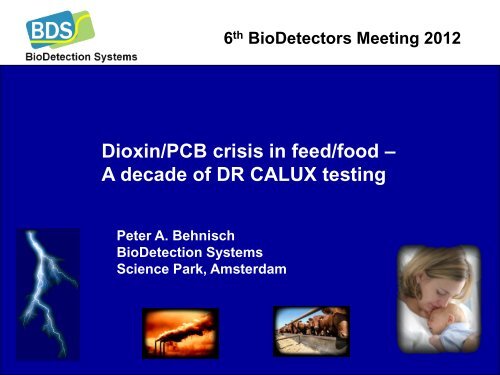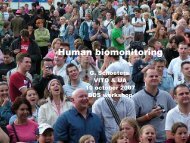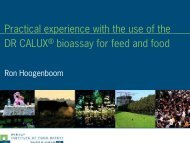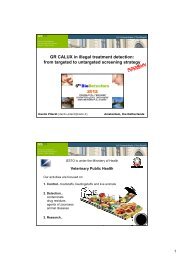Dioxin/PCB crisis in feed/food - BioDetection Systems
Dioxin/PCB crisis in feed/food - BioDetection Systems
Dioxin/PCB crisis in feed/food - BioDetection Systems
Create successful ePaper yourself
Turn your PDF publications into a flip-book with our unique Google optimized e-Paper software.
6 th BioDetectors Meet<strong>in</strong>g 2012<strong>Diox<strong>in</strong></strong>/<strong>PCB</strong> <strong>crisis</strong> <strong>in</strong> <strong>feed</strong>/<strong>food</strong> –A decade of DR CALUX test<strong>in</strong>gPeter A. Behnisch<strong>BioDetection</strong> <strong>Systems</strong>Science Park, Amsterdam1
Outl<strong>in</strong>e of Presentation• Current situation <strong>in</strong> Europe• German <strong>Diox<strong>in</strong></strong> Crisis 2011• Chile Food/Feed monitor<strong>in</strong>g 2008• Dutch Clay/Potato peel<strong>in</strong>g <strong>crisis</strong> 2004• Sydney harbor fish screen<strong>in</strong>g 2005• Slovak Republic Food/Feed monitor<strong>in</strong>g• Norway Fish monitor<strong>in</strong>g school project• Taiwan <strong>feed</strong> and <strong>food</strong> monitoirng• BDS Client survey 2005• Other <strong>food</strong> monitor<strong>in</strong>g programs us<strong>in</strong>g DR CALUX2
Latest diox<strong>in</strong> <strong>crisis</strong>• 2010 – Maize from Ukra<strong>in</strong>e (Nederlands)• 2011 – eggs (Belgium/Netherlands)• 2011 – eggs and milk (Italy)• 2011 – Biodiesel used as <strong>feed</strong> led to 25%polluted market eggs (Germany)• 2011 – Sugar molasses (Germany)• 2012 – Red colorants (The Netherlands)• 2012- Nearly weekly egg recalls <strong>in</strong> Germany by KAT3
New EC guidel<strong>in</strong>es 252/2012, 277/2012 and 278/2012for screen<strong>in</strong>g for diox<strong>in</strong>s/<strong>PCB</strong>s by DR CALUX• Cell based screen<strong>in</strong>g tests can now report samples for diox<strong>in</strong>s anddiox<strong>in</strong>-like <strong>PCB</strong>s as compliant or suspected to be non-compliant(suspected)• New WHO-TEFs are more close to DR CALUX-REPs, lower<strong>in</strong>g theamount of false negative for DR CALUX <strong>in</strong> case of high <strong>PCB</strong>contam<strong>in</strong>ated samples• False-compliant rate with respect to maximum levels is below 5%(before it was 1%)• Repeatability RSD below 20%• 20 confirmed results per matrix group demanded for evaluation of falsenegative rate• Suitable cut-off level at 2/3rd of maxiumum level4
New EC 277 and 278/2012 guidel<strong>in</strong>es:Cut-off levels for DR CALUXMatrixOld Total-TEQOld cutoffNew<strong>Diox<strong>in</strong></strong>NewTotal-TEQPoultry 4 1.5 1.75 3 1.2Bov<strong>in</strong>e 4.5 2.25 2.5 4 1.7Fish 8 3 3.5 6.5 2.3Milk 6 2.25 2.5 5.5 1.7Eggs 6 2.25 2.5 5 1.7Plant oils 1.5 0.56 0.75 1.25 0.5New Cut-OffBaby<strong>food</strong> no no 0.1 0.2 0.075
BDS DR CALUX vs HRGC/HRMS –170 comparisons: < 1% false negativ and < 8% false positiveMatrix N False negative False positiveegg 18 0 3fish 14 0 0Poultry meat 9 0 1Rum<strong>in</strong>ant meat 6 0 0Pig meat 14 0 1fish meal 8 0 0Fish oil 15 0 1milk 33 0 3Feed, plant orig<strong>in</strong> 18 0 4Feed, vegetable oil 7 0 16
Z-SCOREProficiency test performance BDS (2004-2011)21.5Orebro univeristy, round 1European Commission, Jo<strong>in</strong>t Research CentreBICS 2005Goeyens, Belgium10.50-0.5-10 5 10 15 20 25 30 35 40 45 50Norwegian Institute of PublicHealth <strong>in</strong> Oslo, NorwayOrebro univeristy,round 2-1.5-2Dutch National Institutefor Coastal and Mar<strong>in</strong>eManagementQuasimeme round 487
Acceptance by International Quality systems• MVO Code of diox<strong>in</strong>s: 100% of batches for coconut,thermic treated oils and oils direct used as animal<strong>feed</strong> have to be tested by diox<strong>in</strong>s/<strong>PCB</strong>s• Private laboratories have also to report <strong>in</strong> case ofhigher diox<strong>in</strong>/<strong>PCB</strong> levels• Increase quality product labels on EU market suchas IKB (eggs), QS (<strong>feed</strong>) German Meat AssociationVDF s<strong>in</strong>ce Jan 2011, or GMP Plus8
Modernisation by High-Through Put Robot (HTPS)40 samples/hourdos<strong>in</strong>g on 96 wellplates9
High-Through Put Robot (HTPS)40 samples/hourdiox<strong>in</strong> and separate<strong>PCB</strong>-TEQmeasurement10
Outl<strong>in</strong>e of Presentation• Compliance with EU regulations• German <strong>Diox<strong>in</strong></strong> Crisis 2011• Chile Food/Feed monitor<strong>in</strong>g 2008• Dutch Clay/Potato peel<strong>in</strong>g <strong>crisis</strong> 2004• Sydney harbor fish screen<strong>in</strong>g 2005• Slovak Republic Food/Feed monitor<strong>in</strong>g• Norway Fish monitor<strong>in</strong>g school project• BDS Client survey 2005• Other <strong>food</strong> monitor<strong>in</strong>g programs us<strong>in</strong>g DR CALUX11
German <strong>Diox<strong>in</strong></strong> Crisis 201112
Situation <strong>in</strong> January 2011• 4700 farms at first closed – issue taken up by<strong>in</strong>ternational media• 70% of Germans doubted, if their breakfast eggs arediox<strong>in</strong>-free• Ca. 70% lower revenues for farmers/<strong>in</strong>dustry – roughcalculations talked from 20 Mio Euro/week damage• Most local test<strong>in</strong>g needed > 10 days = lack of localtest<strong>in</strong>g capacity• Screen<strong>in</strong>g via DR CALUX offers time and cost sav<strong>in</strong>g• More than 95% of the ca 1800 samples fromGermany tested as express analysis <strong>in</strong> 2-3 days13
Situation <strong>in</strong> January/February 2011• More than 15 countries banned German meat• German Meat Association (VDF) <strong>in</strong> cooperation withGerman Authorities (BMELV) and the Russian ImportAuthorities accepted more than 40 labs for theGerman meat exports – only 4 non-Germanlaboratories• BDS only accepted non-German lab us<strong>in</strong>g screen<strong>in</strong>gtechnology DR CALUX• Regard<strong>in</strong>g acceptance of ISO 17025 accredited labsplease notice that accord<strong>in</strong>g EC/764/2008 all reportsof such accredited labs have to be accepted <strong>in</strong> all ECmember states• BDS ISO 17025 accredited s<strong>in</strong>ce 2005 and newapproved <strong>in</strong> mid 2011 until 201414
German pig meat > 97,6% negative;less than 2.5 % false positive by DR CALUX<strong>PCB</strong>-TEQPCDD/F-TEQTotal-TEQSamplecompliantPCDD/FSamplecompliant TOTALSamplecompliantPCDD/FSamplecompliantTOTAL- 25%- 25%- 50%- 50%PigMeat; NPigMeat;Mean496 496 502 99,8% 97,6 94% 89%0,23 0,21 0,43PigMeat;Range0,1-1,10,1-0,770,1-1,4716
PCDD/D/dl-<strong>PCB</strong>-TEQ byDR CALUXDR CALUX analysis for <strong>PCB</strong> + PCDD/F-TEQ (# 502 samples):German pig meat DistributionTotal-PCDD/F/dl-<strong>PCB</strong>-TEQ by DR CALUX for German pigmeat <strong>in</strong> Jan/Feb 2011 <strong>in</strong> pg PCDD/F/dl-<strong>PCB</strong>-TEQ/g fat1,601,401,201,000,800,600,400,200,00EC guided level 1.5 ng PCDD/F/<strong>PCB</strong>-TEQ/kg fat0 100 200 300 400 500 600Numbers of samples17
PCDD/F-TEQ by DR CALUXDR CALUX analysis for PCDD/Fs (# 496 samples):German pig meat DistributionDistribution PCDD/F-TEQ by DR CALUX for German pig meat <strong>in</strong> Jan/Feb 20110,80EC guided level 1.0 ng PCDD/F-TEQ/kg fat0,700,600,500,400,300,200,100,000 100 200 300 400 500 600Number of tested samples18
German pig liver > 97% negative;less than 3 % false positive by DR CALUX<strong>PCB</strong>-TEQPCDD/F-TEQTotal-TEQSamplecompliantPCDD/FSamplecompliantTOTALSamplecompliantPCDD/FSamplecompliantTOTAL- 25%- 25%- 50%- 50%Pig Liver;NPig Liver;Mean32 37 34 99% 97% 93% 90%0,80 0,78 1,57Pig Liver;Range0,1-2,10,1-3,40,1-5,219
German poultry meat > 98% negative;less than 2 % false positive by DR CALUX<strong>PCB</strong>-TEQPCDD/F-TEQTotal-TEQSamplecompliantPCDD/FSamplecompliantTOTALSamplecompliantPCDD/FSamplecompliantTOTAL- 25%- 25%- 50%- 50%ChickenMeat; NChickenMeat;Mean201 201 207 99,5% 98% 93% 88%0,74 0,56 1,3ChickenMeat;Range0,3-3,30,3 –1,70,6-3,820
PCDD/F/dl-<strong>PCB</strong>-TEQ byDR CALUX <strong>in</strong> ngTEQ/kg fatDR CALUX analysis for PCDD/F/<strong>PCB</strong>-TEQ (# 207 samples):German poultry meat DistributionPCDD/F/dl-<strong>PCB</strong>-TEQ by DR CALUX for Germanpoultry meat <strong>in</strong> Jan/Feb 2011EC guided level 4 ng PCDD/F/<strong>PCB</strong>-TEQ/kg fat432100 50 100 150 200 250Number of samples21
PCDD/F-TEQ by DRCALUX <strong>in</strong> ng TEQ/kgfatDR CALUX analysis for PCDD/F-TEQ (# 201 samples):German poultry meat DistributionPCDD/F-TEQ by DR CALUX of German poultry <strong>in</strong>Jan/Feb 2011 (cut-off 1,4 pg PCDD/F-TEQ/gr fat)2EC guided level 2 ng PCDD/F-TEQ/kg fat1,510,500 50 100 150 200 250Number of samples22
Outl<strong>in</strong>e of Presentation• Compliance with EU regulations• German <strong>Diox<strong>in</strong></strong> Crisis 2011• Kuwait Monitor<strong>in</strong>g of imported <strong>feed</strong>/<strong>food</strong> 2009• Chile Food/Feed monitor<strong>in</strong>g 2008• Dutch Clay/Potato peel<strong>in</strong>g <strong>crisis</strong> 2004• Sydney harbor fish screen<strong>in</strong>g 2005• Slovak Republic Food/Feed monitor<strong>in</strong>g• Norway Fish monitor<strong>in</strong>g school project• BDS Client survey 200523
ng TEQ/kg productTotal DR CALUX ® distribution for FEED samples,2009 Asprocer Program, Chile21.81.60% above max EU PCDD/F-<strong>PCB</strong> limitmax EU limit PCDD/F-<strong>PCB</strong> = 1.5 ng TEQ/kg product1.41.210.80.60.40% above max EU PCDD/F limitmax EU limit PCDD/F = 0.75 ng TEQ/kg product75% max EU PCDD/F limit0.2Santiago, Chile, 22 March 201000 10 20 30 40 50 60 70 80 90 100# of analyses24
ng TEQ/kg productTotal DR CALUX ® distribution for MINERAL samples,2009 Asprocer Program, Chile338 ng TEQ/kg productm<strong>in</strong>eral clay2.5z<strong>in</strong>c oxide21.55.4% above max EU PCDD/F-<strong>PCB</strong> limitmax EU limit PCDD/F-<strong>PCB</strong> = 1.5 ng TEQ/kg productz<strong>in</strong>c oxidez<strong>in</strong>c oxidem<strong>in</strong>eral clayz<strong>in</strong>c oxide17.6% above max EU PCDD/F limitmax EU limit PCDD/F = 0.75 ng TEQ/kg productm<strong>in</strong>eral clay0.575% max EU PCDD/F limit00 10 20 30 40 50 60 70 80 90 100# of analysesSantiago, Chile, 22 March 201025
ng TEQ/kg productTotal DR CALUX ® distribution for FISH OIL samples,2009 Asprocer Program, Chile25200% above max EU PCDD/F-<strong>PCB</strong> limitmax EU limit PCDD/F-<strong>PCB</strong> = 24 ng TEQ/kg product15100% above max EU PCDD/F limitmax EU limit PCDD/F = 6 ng TEQ/kg product575% max EU PCDD/F limit00 2 4 6 8 10# of analysesSantiago, Chile, 22 March 201026
ng TEQ/kg productTotal DR CALUX ® distribution for ANIMAL OIL samples,2009 Asprocer Program, Chile43.530% above max EU PCDD/F-<strong>PCB</strong> limitmax EU limit PCDD/F-<strong>PCB</strong> = 3 ng TEQ/kg product2.520% above max EU PCDD/F limitmax EU limit PCDD/F = 2 ng TEQ/kg product1.575% max EU PCDD/F limit10.500 2 4 6 8 10 12# of analysesSantiago, Chile, 22 March 201027
ng TEQ/kg productTotal DR CALUX ® distribution for VEGATABLE OIL samples,2009 Asprocer Program, Chile2.521.50% above max EU PCDD/F-<strong>PCB</strong> limitmax EU limit PCDD/F-<strong>PCB</strong> = 1.5 ng TEQ/kg product118% above max EU PCDD/F limitmax EU limit PCDD/F = 0.75 ng TEQ/kg product0.575% max EU PCDD/F limit00 5 10 15 20# of analysesSantiago, Chile, 22 March 201028
Outl<strong>in</strong>e of Presentation• Compliance with EU regulations• German <strong>Diox<strong>in</strong></strong> Crisis 2011• Chile Food/Feed monitor<strong>in</strong>g 2008• Dutch Clay/Potato peel<strong>in</strong>g <strong>crisis</strong> 2004• Sydney harbor fish screen<strong>in</strong>g 2005• Slovak Republic Food/Feed monitor<strong>in</strong>g• Norway Fish monitor<strong>in</strong>g school project• BDS Client survey 2005• Other <strong>food</strong> monitor<strong>in</strong>g programs us<strong>in</strong>g DR CALUX29
TEQ (pg/g fat)Dutch <strong>Diox<strong>in</strong></strong> <strong>crisis</strong> 2004:Clay effect<strong>in</strong>g potato peel<strong>in</strong>g used a animal <strong>feed</strong>.total DR CALUX TEQ distribution for milk samples, 2004 Dutch clay <strong>crisis</strong>1098761.3 % above 6 pg TEQ/g54325.8 % above 3 pg TEQ/g0 50 100 150 200 250 300 3501060 % below 1.5 pg TEQ/greported TEQ (sorted from lowest to highest)30
Outl<strong>in</strong>e of Presentation• International <strong>food</strong>/<strong>feed</strong> <strong>crisis</strong>• Compliance with EU regulations• Chemical TEQ vs. DR CALUX TEQ – a few examples• Dutch Clay/Potato peel<strong>in</strong>g <strong>crisis</strong> 2004• Sydney harbor fish screen<strong>in</strong>g 2005• Slovak Republic Food/Feed monitor<strong>in</strong>g• Norway Fish monitor<strong>in</strong>g school project• Other Monitor<strong>in</strong>g Programs31
Australia 2006Soils Recycled Organics & Remediation Technologies Unit,Sydney, Australia<strong>Diox<strong>in</strong></strong>s: A fishy bus<strong>in</strong>ess;the analysis of diox<strong>in</strong>s <strong>in</strong> sea<strong>food</strong> from Sydney Harbour32
Sydney Harbour; prelim<strong>in</strong>ary results33
Time l<strong>in</strong>e rapid implementationWeektra<strong>in</strong><strong>in</strong>g CALUXcha<strong>in</strong> of custodyoptimalisation lab11 12 13 1415 16QA/QC data set1825 3545total TEQ test<strong>in</strong>g12 2432 5070<strong>PCB</strong> TEQ test<strong>in</strong>g1224325070evaluation accreditationfish samples done1224325070analiysis done42739914518534
Sydney harbour:Comparison of DR CALUX ® and HR-GCMS1286432DR CALUX ®(log scale)1684210.50.51248163264128HRGCMS(log scale)35
Outl<strong>in</strong>e of Presentation• International <strong>food</strong>/<strong>feed</strong> <strong>crisis</strong>• Compliance with EU regulations• Chemical TEQ vs. DR CALUX TEQ – a few examples• Dutch Clay/Potato peel<strong>in</strong>g <strong>crisis</strong> 2004• Sydney harbor fish screen<strong>in</strong>g 2005• Slovak Republic Food/Feed monitor<strong>in</strong>g• Norway Fish monitor<strong>in</strong>g school project• Other <strong>food</strong> monitor<strong>in</strong>g programs us<strong>in</strong>g DR CALUX36
total DR CALUX TEQ/max EC total TEQ leveltotal DR CALUX TEQ/max EC total TEQ levelNational Monitor<strong>in</strong>g Programfrom State Veter<strong>in</strong>ary and Food Service of Slovak RepublicRatio:Total DR CALUX TEQ vs. accepted European Total-TEQ1.25Bov<strong>in</strong>e Meat1.25Pork Meat1.001.000.750.750.500.500.250.250.000 2 4 6 8 100.000 2 4 6 8 10 12LocationLocationCALUX Exchange 2006 Presentation37
total DR CALUX TEQ/max EC total TEQ leveltotal DR CALUX TEQ/max EC total TEQ levelNational Monitor<strong>in</strong>g Programfrom State Veter<strong>in</strong>ary and Food Service of Slovak RepublicRatio:Total DR CALUX TEQ vs. accepted European Total-TEQ1.25Egg1.25Milk1.001.000.750.750.500.500.250.250.000 2 4 6 8 10 12 140.000 2 4 6 8 10 12LocationLocationCALUX Exchange 2006 Presentation38
total DR CALUX TEQ/max EC total TEQ leveltotal DR CALUX TEQ/max EC total TEQ levelNational Monitor<strong>in</strong>g Programfrom State Veter<strong>in</strong>ary and Food Service of Slovak RepublicRatio:Total DR CALUX TEQ vs. accepted European Total-TEQ1.25Fish1.25Poultry1.000.750.50Location 10:Ratio 3.4 due to former<strong>PCB</strong> production1.000.750.500.250.250.000 5 10 15 200.000 5 10LocationLocationCALUX Exchange 2006 Presentation39
Outl<strong>in</strong>e of Presentation• International <strong>food</strong>/<strong>feed</strong> <strong>crisis</strong>• Compliance with EU regulations• Chemical TEQ vs. DR CALUX TEQ – a few examples• Dutch Clay/Potato peel<strong>in</strong>g <strong>crisis</strong> 2004• Sydney harbor fish screen<strong>in</strong>g 2005• Czech Food/Feed monitor<strong>in</strong>g• Norway Fish monitor<strong>in</strong>g school project• Taiwan Feed/Food Monitor<strong>in</strong>g• Other <strong>food</strong> monitor<strong>in</strong>g programs us<strong>in</strong>g DR CALUX40
School students work<strong>in</strong>gas environmental scientists-”Global POP”<strong>Diox<strong>in</strong></strong>s <strong>in</strong> fish with BDS CALUXEldbjørg Sofie Heimstad 1 , Gaute Grønstøl 2 , Karl Torste<strong>in</strong>Hetland 3 , Javier Mart<strong>in</strong>ez Alarcon 1 , Charlotta Rylander 1,4and Espen Mariussen 1,51Norwegian Institute for Air Research (NILU)2University of Bergen, Bergen.3Norwegian Centre for Science Education4Institute of Community Medic<strong>in</strong>e, University of Tromsø5Norwegian Defence Research Establishment (FFI)41
Global POP – a school projectKids participate with field work anddata publish<strong>in</strong>g <strong>in</strong> a research projectInvestigate diox<strong>in</strong>s and diox<strong>in</strong>-likecompounds (CALUX) <strong>in</strong> fish commonfor consumptionSchools from Arctic areas will beencouraged to participate. TEQ will bedeterm<strong>in</strong>ed by NILU <strong>in</strong> fish that werecaught by the studentsInvestigate diox<strong>in</strong>s and diox<strong>in</strong>-likecompounds (CALUX) <strong>in</strong> fish commonfor consumption42
Norwegian Fish Monitor<strong>in</strong>g Project; Polar Bear43
Salvel<strong>in</strong>us alp<strong>in</strong>usAnguilla anguillaGadus morhuaPleuronectes platessaSebastes mar<strong>in</strong>usPollachius virensSalmo truttaPollachius pollachiusPerca fluviatilisCypr<strong>in</strong>us caprioCoregonus lavaretusPlatichtys flesusScomber scombusLota lotaMelanogramus aeglef<strong>in</strong>usMolva molvaLeuciscus cephalusEsox luciusRutilus rutilusBlicca bjoerknaLimanda limandaMugil cephalusSparus aurataAcanthopagrus australisAcanthopagrus butcheriWithout datasheetGlobal POP50454035302520151050NumberNumberGadus morhua, cod.Perca fluviatilis, European perch.Salmo trutta, trout.44
EU wide Fish Monitor<strong>in</strong>g from 54 schools45
DL-<strong>PCB</strong>s+PCDD/FsPCDD/FsMay 2009:Countries: 11Schools: 51Fish samples:19246
TEQ(pg/g)07'199607'200407'200807'201207'203708'33308'33708'34708'33908'34308'36108'36508'36908'37308'38808'39208'39608'40008'48408'50708'54608'62108'64508'35608'65908'74808'75208'75608'76008'80508'80908'81908'87708'106608'107008'127508'139008'139408'156608'1596Low average level of all samples: 0,42 (pg TEQ/g)2,001,501,00AverageTEQ0,500,00Sample number47
River fish higher than coastal fishN Norway: n=27,S Norway n=4348
Outl<strong>in</strong>e of Presentation• Compliance with EU regulations• German <strong>Diox<strong>in</strong></strong> Crisis 2011• Chile Food/Feed monitor<strong>in</strong>g 2008• Dutch Clay/Potato peel<strong>in</strong>g <strong>crisis</strong> 2004• Sydney harbor fish screen<strong>in</strong>g 2005• Slovak Republic Food/Feed monitor<strong>in</strong>g• Norway Fish monitor<strong>in</strong>g school project• Taiwan Monitor<strong>in</strong>g of <strong>feed</strong> and <strong>food</strong>• BDS Client survey 2005• Other <strong>food</strong> monitor<strong>in</strong>g programs us<strong>in</strong>g DR CALUX49
TACTRI/COA <strong>in</strong> Taiwan: Egg and Fish monitor<strong>in</strong>gSample Nr of samples Fat % Total-TEQEggs 31 10 2.0 (1.3-4.8)Eel-Feed 6 9 0,4 (0.2-0.5)Seabass-Feed 9 11 0.9 (0.3-1.7)Tilapia-Feed 8 8 0.3 (0.2-0.5)Duck eggs 8 15 1.8 (1.4-2.4)Salted duck eggs 16 46 1,2 (0.6-2.8)50
Outl<strong>in</strong>e of Presentation• Compliance with EU regulations• German <strong>Diox<strong>in</strong></strong> Crisis 2011• Chile Food/Feed monitor<strong>in</strong>g 2008• Dutch Clay/Potato peel<strong>in</strong>g <strong>crisis</strong> 2004• Sydney harbor fish screen<strong>in</strong>g 2005• Slovak Republic Food/Feed monitor<strong>in</strong>g• Norway Fish monitor<strong>in</strong>g school project• Taiwan Monitor<strong>in</strong>g of <strong>feed</strong> and <strong>food</strong>• BDS Client survey 2005• Other <strong>food</strong> monitor<strong>in</strong>g programs us<strong>in</strong>g DR CALUX51
BDS clients survey <strong>in</strong> 2006:<strong>Diox<strong>in</strong></strong>/<strong>PCB</strong>-TEQ by DR CALUX ® TEQ<strong>in</strong> <strong>food</strong> samples (n=490)52
BDS clients survey <strong>in</strong> 2006:<strong>Diox<strong>in</strong></strong>/<strong>PCB</strong>-TEQ by DR CALUX ® TEQ<strong>in</strong> <strong>feed</strong> samples (n=100)53
Outl<strong>in</strong>e of Presentation• Compliance with EU regulations• German <strong>Diox<strong>in</strong></strong> Crisis 2011• Chile Food/Feed monitor<strong>in</strong>g 2008• Dutch Clay/Potato peel<strong>in</strong>g <strong>crisis</strong> 2004• Sydney harbor fish screen<strong>in</strong>g 2005• Slovak Republic Food/Feed monitor<strong>in</strong>g• Norway Fish monitor<strong>in</strong>g school project• Taiwan Feed/Food Monitor<strong>in</strong>g• BDS Client survey 2005• Other monitor<strong>in</strong>g programs us<strong>in</strong>g DR CALUX54
Other Monitor<strong>in</strong>g Programs us<strong>in</strong>g DR CALUX ®I. Ireland 2008 – used <strong>PCB</strong> electricity transformator oil <strong>in</strong> <strong>food</strong>recycl<strong>in</strong>g contam<strong>in</strong>ated more than 80% of pig meat export Intensive monitor<strong>in</strong>g program <strong>in</strong>cl. DR CALUX ® .II. Italian „Mozarella Crisis“ <strong>in</strong> 2008 Intensive monitor<strong>in</strong>g program of local farmer association <strong>in</strong>cl.DR CALUX ® III. E.g. Israel, Mauretania, Chile, Thailand, Ch<strong>in</strong>a, Korea,Spa<strong>in</strong>…. are currently runn<strong>in</strong>g monitor<strong>in</strong>g programs via DRCALUX55
Mother milk <strong>in</strong> Hong Kong and Ch<strong>in</strong>aComparison DR CALUX-Total-TEQ (BDS) and HRGC/HRMS WHO-Total-TEQ (WHO Reference lab) for pooled breast milksamples (pg/g fat) from Hui et al. Chemosphere 69, 1287 (2007)181614DR CALUXWHO Lab (TEF1997)WHO Lab (TEF2005)1210864201. HongKong (eversmokers,n=25; age 26.5)2. HongKong (highdairy product<strong>in</strong>take,16;31)3. HongKong (highsea<strong>food</strong><strong>in</strong>take, 17;30.5)4. HongKong (lowdairy ANDlow sea<strong>food</strong><strong>in</strong>take, 32;31.4)5. HongKong (highdairy ORhigh sea<strong>food</strong><strong>in</strong>take, 28;32.6)6. Ma<strong>in</strong>landCh<strong>in</strong>a (lowdairy ANDlow sea<strong>food</strong><strong>in</strong>take, 21;26.6)7. Ma<strong>in</strong>landCh<strong>in</strong>a (highdairy ORhigh sea<strong>food</strong><strong>in</strong>take, 34;28.1)8. Ch<strong>in</strong>aImmigrant(2–6 yearsstay <strong>in</strong> HongKong, 22;27.6)9. Ch<strong>in</strong>aImmigrant (7years stay <strong>in</strong>Hong Kongor above, 23;30.1)10. Overseas(1–10 yearsof overseasstay, 18;32.1)11. Overseas(11 years ofoverseasstay orabove, 10;25.7)Overall (246;30)56
Take home message• The DR CALUX cell-based screen<strong>in</strong>g method is used for <strong>feed</strong>/<strong>food</strong>test<strong>in</strong>g s<strong>in</strong>ce more than 15 years….and evaluated <strong>in</strong> many laboratory <strong>in</strong>many countries• The new EC guidel<strong>in</strong>es open now via the qualitative screen<strong>in</strong>gapproach an easier and faster approach for the report<strong>in</strong>g of compliantor suspected samples• BDS is further focus<strong>in</strong>g to decrease the costs for the PCDD/F/<strong>PCB</strong>-TEQ analysis (under ISO 17025 mode) via easier clean-up methods andRobotics!• The results of these studies shows aga<strong>in</strong> that the DR CALUX ® bioassayfor screen<strong>in</strong>g of PCDD/Fs and diox<strong>in</strong>-like <strong>PCB</strong>s <strong>in</strong> <strong>feed</strong> and <strong>food</strong> is animportant device to identify the few percentage of the EU limitexceed<strong>in</strong>g samples among the bulk of the compliant samples….!!!57





